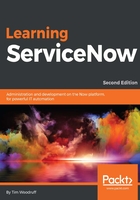
Chapter 2. Lists and Forms
In this chapter, we'll discover how lists in ServiceNow are similar to tables in any other relational database, and just what exactly that means for our data. We'll learn how relationships between data are created and stored in these lists, and get a brief introduction to the data types in ServiceNow. While we're at it, we'll also learn how to either personalize or configure how list data is displayed, and edited.
As an integral part of understanding data structures in ServiceNow, we'll also learn about forms and form views, the types of data that you'll see in forms and lists, and how to personalize or configure what data shows up where.
In this chapter, you'll also learn how to create a custom table as part of the foundation for your first application: a Virtual War Room for major incidents. This application will be used to demonstrate various pieces of functionality throughout the ServiceNow platform for the earlier chapters of this book, so it would be a good idea to follow along!
Remember: lists are where data rows and columns are displayed for multiple records. Forms are where a single record is displayed, and where work is done in ServiceNow. As you might imagine, there's a lot to learn about them both! In summary, this chapter will cover the following topics:
- The list view, and list components
- List v2 versus List v3
- Creating custom tables
- Creating update sets to track your work within tables (and elsewhere)
- Adding fields, and filtering tables
Note
In Helsinki and later versions of ServiceNow, there are two versions of lists available: List v2, and List v3. For the most part, we'll use the example of List v3 in this book, but will attempt to call out important differences since List v2 is still used exclusively in some circumstances.
If it's not already active (such as if you've upgraded from a version prior to Helsinki), you can activate the List v3 plugin from System Definition | Plugins.